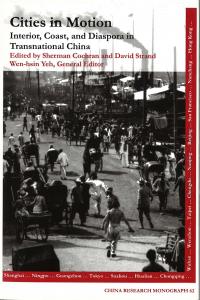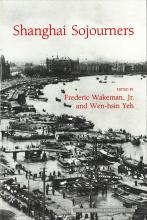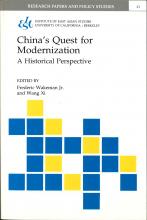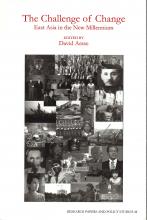Cities in Motion
Cities in Motion
David Strand, ed., Sherman Cochran, ed., Wen-hsin Yeh, ed.
This volume offers a fresh perspective on how Chinese cities were transformed or "Westernized" in the late nineteenth and twentieth centuries and how Asian and Western cities received Chinese influences dispatched through the media of commerce and migration. Part 1 looks at organizing human life; part 2 at movement and networking; part 3 at importing the modern city; and part 4 at exporting the Chinese city.
As a nonprofit academic press, we need your support to publish our books. Your gift can help us make more of our titles available as e-books. DONATE NOW
Title information
This volume offers a fresh perspective on how Chinese cities were transformed or "Westernized" in the late nineteenth and twentieth centuries and how Asian and Western cities received Chinese influences dispatched through the media of commerce and migration. Contributors:
Sherman Cochran is Hu Shih Professor of Chinese History at Cornell University.
Karl Gerth is a University Lecturer in modern history at Oxford University and Fellow of Merton College.
Madeline Y. Hsu is Director of the Center for Asian American Studies at the University of Texas at Austin and an Associate Professor in the Department of History.
C. Julia Huang is Associate Professor of Anthropology at National Tsing Hua University, Hsinchu, Taiwan.
Klaus Mühlhahn is Professor of History, Indiana University.
Caroline Reeves is a member of the History Department at Emmanuel College in Boston.
Allison Rottman is an independent scholar in Oakland, California.
Vimalin Rujivacharakul is an Assistant Professor of Art and Architectural History at the University of Delaware.
Brett Sheehan is Associate Professor of Chinese history at the University of Southern California.
Elizabeth Sinn was Associate Professor and Deputy Director of the Centre of Asian Studies, University of Hong Kong, before her retirement in 2004.
Kristin Stapleton is Director of Asian Studies and a member of the History Department at the University at Buffalo (SUNY).
David Strand teaches political science, East Asian studies, and history at Dickinson College.
Robert P. Weller is Professor and Chair of Anthropology at Boston University.
Wen-hsin Yeh is Richard H. and Laurie C. Morrison Professor in History and Director of the Institute of East Asian Studies, University of California, Berkeley.
David Strand, ed.
David Strand is Charles A. Dana Professor of Political Science at Dickinson College.
B.A. Lawrence University, M.A. Columbia University, M. Phil. Columbia University, Ph.D. Columbia University
Sherman Cochran, ed.
Sherman Cochran is Hu Shih Professor Emeritus of Chinese History at Cornell University.
B.A. Yale University, M.A. Yale University, Ph.D. Yale University
Wen-hsin Yeh, ed.
Wen-hsin Yeh is professor of history at the University of California, Berkeley. She has served as the director of the Institute of East Asian Studies and the chair of the Center for Chinese Studies at Berkeley. She has edited and contributed to many IEAS publications, including Mobile Subjects; Mobile Horizons; History in Images; Cities in Motion; Empire, Nation, and Beyond; Cross-Cultural Readings of Chineseness; Landscape, Culture, and Space in Chinese Society; and Shanghai Sojourners.
B.A., History, National Taiwan University; M.A., History, University of Southern California; Ph.D., History, University of California, Berkeley
Cities in Motion
- Cities in Motion: An Introduction—1
- David Strand and Sherman Cochran
- Part I: Organizing Urban Life—25
- 1. Grave Concerns: Bodies, Burial, and Identity in Early Republican China—27
Caroline Reeves - 2. Warfare and Modern Urban Administration in Chinese Cities—53
Kristin Stapleton - Part II: Movements and Networking—79
- 3. Webs and Hierarchies: Banks and Bankers in Motion, 1900–1950—81
Brett Sheehan - 4. To the Countryside: Communist Recruitment in Wartime Shanghai—106
Allison Rottmann - Part III: Importing the Modern City—131
- 5. Architects as Cultural Heroes—133
Vimalin Rujivacharakul - 6. Shanghai Fashion: Merchants and Business as Agents of Urban Vision—154
Karl Gerth - 7. Visions of Order and Modernity: Crime, Punishment, and Justice in Urban China during the Republican Period—182
Klaus Mühlhahn - Part IV: Exporting the Chinese City—217
- 8. Exporting Homosociality: Culture and Community in Chinatown America, 1882–1943—219
Madeline Hsu - 9. Moving Bones: Hong Kong's Role as an "In-between Place" in the Chinese Diaspora—247
Elizabeth Sinn - 10. Charisma in Motion: The Compassion Relief Movement in Taiwan, Japan, Malaysia, and the United States—272
Robert P. Weller and C. Julia Huang - Index—295
- Contributors—311
|
JOURNAL REVIEWS |
|
"[This is a] collection of excellent studies on movement and flow in China's urban networks. The volume can just as easily be praised for displaying the richness with which spatial questions are now being explored by China scholars. Furthermore, the book makes an excellent pedagogical resource by inviting students to ask important questions about "the spatial approach" to Chinese history." ~Tim Oakes, University of Colorado, Boulder, in The China Journal, no. 61 (January 2009): 155–157 (http://www.jstor.org/stable/20648055) |
|
"This is a bold and fascinating collection of essays by a group of distinguished authors who work in different areas of modern Chinese history. The themes that join their work together are movement and migration. The volume makes a strong and direct recognition of the key role of migration, in all its forms, in modern Chinese history." ~Diana Lary, in China Review International 17, no. 4 (2010): 421–424 (http://www.jstor.org/stable/23733315) |
|
"This volume builds usefully upon the expanding literature on Chinese urban environments and their many linkages, enriching the subject by providing new sets of details and intriguing avenues of inquiry. The editors' introduction also adequately surveys the relevant features of this historiography. As such, the collection enhances the scholarly understanding of Chinese society at large." ~Bill Sewell, Saint Mary's University, in Pacific Affairs 81, no. 2 (Summer 2008): 267–269 (http://www.jstor.org/stable/40377537) |
|
“[A] chief inspiration for the anthology is the notion of motion, not in the sense of activity within the city (although that certainly is featured in some articles), but rather in the motion of ideas between and across urban settings throughout China….The articles in the book demonstrate the permeability of regional and national borders in China’s late-Imperial- and Republican-era transformations. ‘Motion’, therefore, often seems a rather more important term than ‘cities’ in many of the chapters….The work does definitely belong on the bookshelf of those interested in modern China.” ~Johnathan Farris, Savannah College of Art and Design in Hong Kong, in Planning Perspectives 26, no. 3 (July 2011): 505–507 (http://dx.doi.org/10.1080/02665433.2011.575564) |





